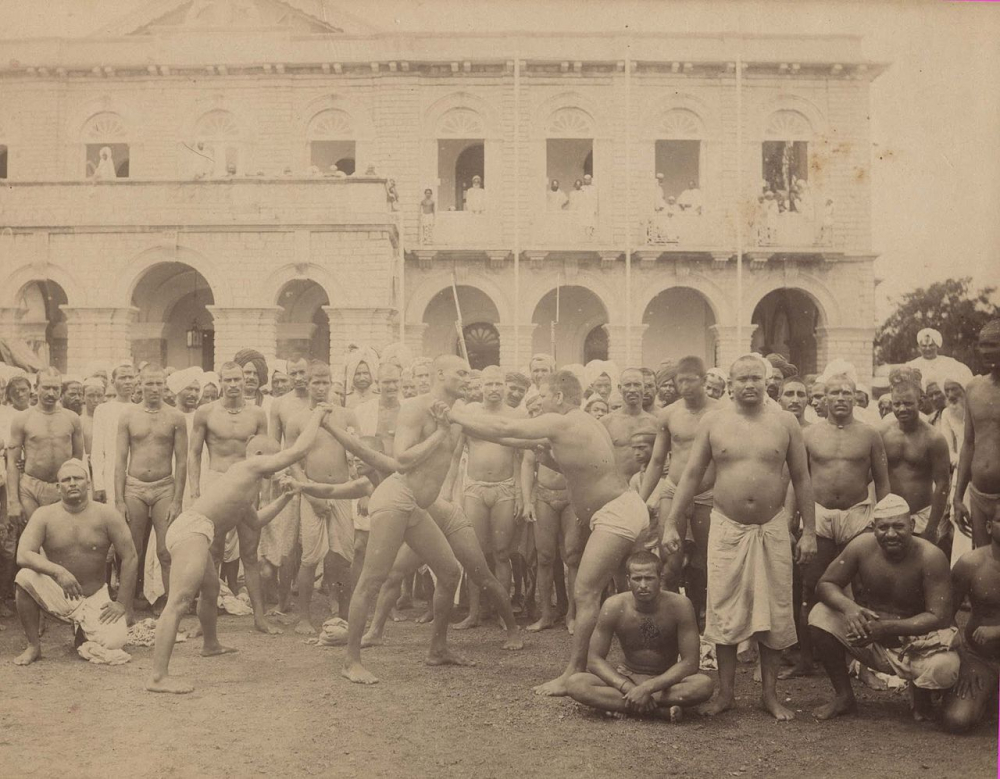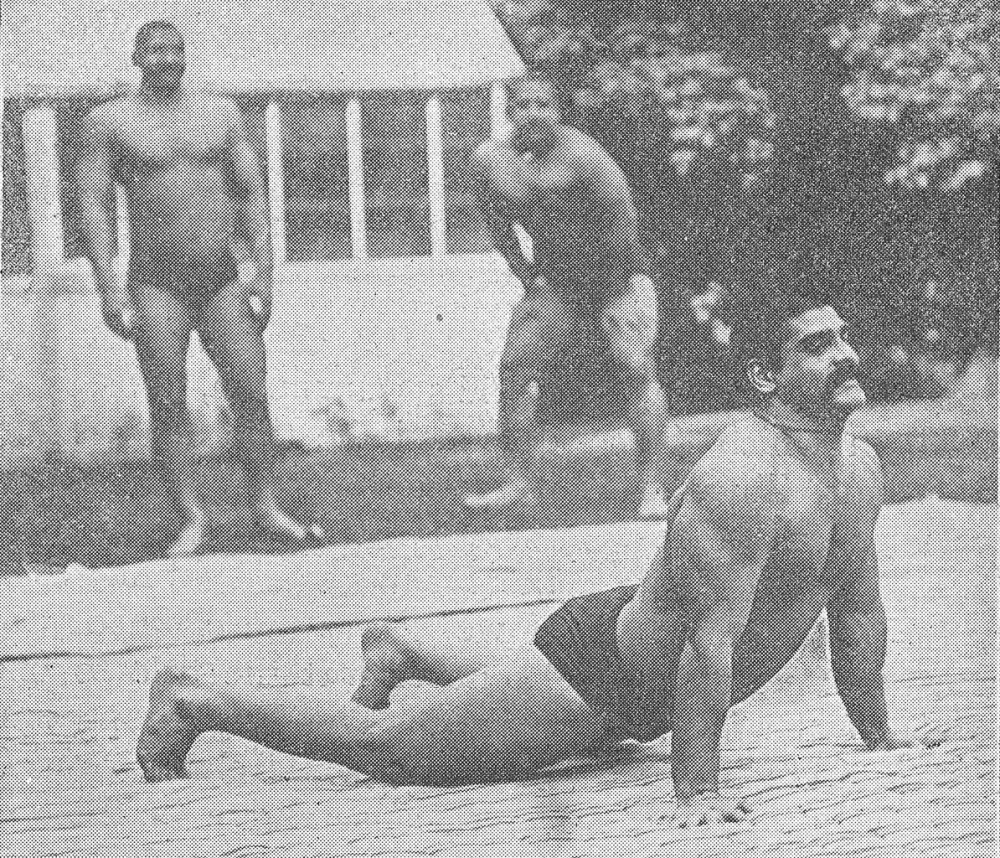Barely 18, Gobar Goho could envision the potential of Indian wrestlers on the world ring, long before anyone else did. Around 50 years after his death, we delve into history to look back at the man who had initially found himself in a profession of his father’s choosing, but went on to become one of the pioneers and visionaries of the sport of wrestling in India. (In Pic: A bust of Gobar Goho in Hedua Park, Kolkata; Photo Source: BengaliHindu/Wikimedia Commons)
It was 1909. Wrestling, a popular pastime in the Indian subcontinent for centuries, especially under royal patronage, was disappearing along with India’s princely states. However, it took the suggestion of a barely 18-year-old Gobar Goho to change not only how the wrestling world looked at India, but also the way Indian wrestlers looked at themselves. Now, over a century and hundreds of international medals—including five at the Olympics—later, Indian wrestlers are known to be serious contenders at international sporting events.
But who is this uniquely named Gobar Goho, and how did the teenager change the face of wrestling in India? Around 50 years after his death, we delve into history to look back at the man who had initially found himself in a profession of his father’s choosing, but went on to become one of the pioneers and visionaries of the sport of wrestling in India.
Can't Fight Destiny
Jatindra Charan Guho was born on March 13, 1892, in Kolkata, West Bengal, into a wrestlers' family. This included the famous Ambu Babu, who had set up an akhada (arena) at Masjidbari Street, and Khetracharan Guho, who is known to have tutored Swami Vivekananda. Like the many odd terms of endearments used for children in Bengal, Guho’s father Ram Charan would call him ‘Gobar’ (cowdung). This was probably to chide him for being lazy and overweight. Jatindra eventually became ‘Gobar Goho’, when 'Goho'—the anglicised version of Guho—was added.

Wrestling had been a popular pastime in the Indian subcontinent for centuries. However, akhadas such as this one in Hyderabad (circa 1870) started disappearing along with Indian princely states in the mid-19th century (Photo Source: Wikimedia Commons)
Despite growing up around wrestling, Goho showed no interest in taking up the sport. In fact, he was instead receiving training in Hindustani classical music. However, after his father died in 1901, his family—unwilling to let the family’s association with wrestling end with Ram Charan—decided that the heavy-built nine-year-old Goho should pick up the sport.
He was a natural, and by the age of 15—under guidance from his uncle Khetracharan—had become a proper pahalwan (a wrestler). Soon his uncle hired Rehman, a well-known guru from Amritsar, as Goho’s personal trainer. Just as he started establishing himself as a professional wrestler in 1909, his uncle died. It was a huge personal and professional blow for the budding pahalwan.
This was also around the time when the revolutionary wave against the British was in full force across the country, including Bengal. Many of the akhadas, several of which had been instituted by his grandfather Ambu Babu, were becoming fronts for the underground network of armed revolutionaries and training bases for local goondas. Goho, who loved wrestling as an art and a sport, took on the initiative to re-establish wrestling as a serious sport.
The Teen Visionary
While 1909 brought sorrow to Goho, it was also the year that changed his life and, owing to his vision, possibly the trajectory of Indian wrestling. Concerned about the deteriorating state of wrestling and wrestlers in the country, Goho wanted to follow his family’s footsteps and make a difference. Serendipity struck in the form of a trip to Lahore with his brother-in-law Sarat Kumar Mitra, an affluent businessman with a penchant for wrestling. They were going there to witness a much-hyped match between two contemporary wrestling greats: Ghulam Mohammad Baksh Butt (known as The Great Gama) and Rahim Sultaniwala.

Ghulam Mohammad Baksh Butt (aka The Great Gama) was part of the first contingent of Indian wrestlers to London—a trip that was conceived of by Gobar Goho (Photo Source: Wikimedia Commons)
These two pahalwans had met twice already and both battles had been gruesome without a clear winner. Lahore too proved to be a tight contest that lasted two gruelling hours. The intensity and quality of the fight inspired the young Goho to ponder: ‘What if wrestlers like Gama, Sultaniwala and their ilk were taken to the heart of the British Empire—London—to fight with international wrestlers? That would surely show the world just how good Indians are.’
Goho mentioned this to Mitra, who immediately agreed to finance the ambitious trip. So, in 1910, a small troupe—Gama, his brother Imam Baksh, Ahmed Baksh and Gamu (all from the same akhada), a cook, some helpers, and Mitra and Goho, of course—landed in England. While the others went on, this turned out to be an extremely short trip for the teenager Goho, who had travelled without letting his family know. So, once they found out, Goho was asked to immediately return home on account of his mother's ill health. He did.
What followed in England were months of immense struggle for Gama and his team, before they emerged victorious. While that is, of course, Gama’s tale, one cannot forget that it was Goho's vision that made this historic venture possible. This trip put India on the world wrestling map.
One Fight at a Time
While teen Goho might have returned to India abruptly, the exceptional pahalwan did end up travelling to several countries soon after, conquering the wrestling world one bout at a time. During a European tour in 1913, Goho fought and defeated several big names like Jimmy Campbell and Jimmy Essen. However, the fight that has now become part of wrestling folklore is the big win over US’ Ad Santel, the light heavyweight champion of the world, in 1921.
The ‘Hindu Giant’, as the San Francisco Chronicle described Goho, proved to be too strong for Santel, winning the bout in 1 hour and 3 minutes with a crotch hold. In 1996, India commemorated the platinum jubilee of the ‘world wrestling championship’ between Goho and Santel with a special stamp. Another famous bout was with American Ed ‘Strangler’ Lewis, the fiercest and most popular wrestler at the time. Goho went on to lose that match but not before giving Lewis a tough fight.
Goho spent six years in the US, alongside the world’s best wrestlers in the early 1920s—Stanislaus Zbyszko, Ad Santel and John Lemm, to name a few. By 1927, Goho’s American adventure came to an end. He returned home and took over the reins of the family akhada. On January 2, 1972, the 79-year-old ‘Indian prince from Calcutta’ passed away in the very akhada he had grown to love.
This article was also published on IndianExpress.com











